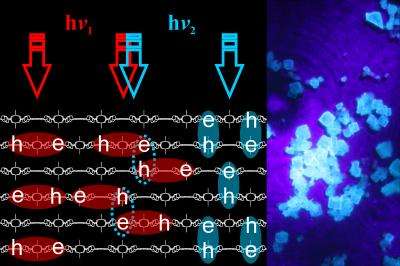New material helps record data with light

Russian physicists with their colleagues from Europe have learned to generate quasiparticles—excitons, which were fully controllable and able to record information at room temperature. These particles act as a transitional form between photons and electrons, so the researchers believe they can be used to create compact optoelectronic devices for rapid recording and processing of optical signals. The proposed method is based on use of a special class of materials called metal-organic frameworks. The researchers published their results in Advanced Materials.
To simplify the description of complex effects in quantum mechanics, scientists have introduced a concept of quasiparticles. One of them, which is called exciton, is an "electron-hole" pair, which provides energy transfer between photons and electrons. According to the scientific community, this mediation of quasiparticles will help to combine optics with electronics and create a fundamentally new class of equipment that is more compact and energy efficient. However, all exciton demo devices either operate only at low temperature, or are difficult to manufacture, which inhibits their mass adoption.
In the new study, the scientists generated excitons at room temperature by changing the light parameters. The authors also managed to control the quasiparticles with ultra-high sensitivity of hundreds of femtoseconds. Finally, they developed an easy method for data recording with excitons. This was possible through the use of an individual class of materials called metal-organic frameworks.
Metal-organic frameworks (MOF) synthesized at ITMO University have a layered structure. Between the layers, there is a physical attraction called the van der Waals force. To prevent the plates from uncontrollably coming together, the interlayer space is filled with an organic liquid, which fixes the framework to three dimensions.
In such crystals, the researchers learned to bring two types of excitons individually: intralayer and interlayer. The first arise when a photon absorbed by the crystal turns into an electron-hole pair inside a layer, but the second appear when an electron and a hole belong to neighboring layers. Over time, both kinds of quasiparticles disintegrate, re-radiating the energy as a photon. But excitons can move around the crystal while they exist.
The lifetime of intralayer excitons is relatively short, but their high density and agility allow their use for generating light in LEDs and lasers, for instance. Interlayer excitons are more stable, but slow moving, so the researchers propose they be used for the data recording. Both types of excitons are suitable for processing of optical signals, according to the physicists.
The innovative approach for information recording concerns the changing a distance between crystal layers to switch "on" and "off" the interlayer excitons. Valentin Milichko, the first author of the paper, says, "We locally heated the crystal with a laser. In the place of exposure, the layers stuck together and the luminescence of excitons disappeared while the rest of the crystal continued shining. This could mean that we recorded one bit of information, and the record, in the form of a dark spot, was kept for many days. To delete the data, it was enough to put the MOF into the same organic liquid that supports layers. In this case, the crystal itself is not affected, but the recorded information (the dark spot) disappears."
The authors believe that in the future, the new material will bring processing of optical signals to the usual pattern of zeros and ones: "In fact, we can influence the exciton behavior in the crystal, changing the light intensity. At weak irradiation, excitons are accumulated (in a 'one' state), but if the laser power increases, the concentration of quasiparticles grows so much that they can instantly disintegrate (in 'zero' state)," says Valentin Milichko.
Typically, excitons occur in dielectric and semiconductor crystals, but the scientists could create these quasiparticles and get control over them in a completely different class of materials for the first time. The MOF crystal combines organic and inorganic components, which gives it additional properties not available for materials of a single nature. Thus, the organic component allows researchers to generate excitons at room temperature, but the inorganic component provides their efficient transfer around the crystal.
More information: Valentin A. Milichko et al, van der Waals Metal-Organic Framework as an Excitonic Material for Advanced Photonics, Advanced Materials (2017). DOI: 10.1002/adma.201606034
Journal information: Advanced Materials
Provided by ITMO University



















